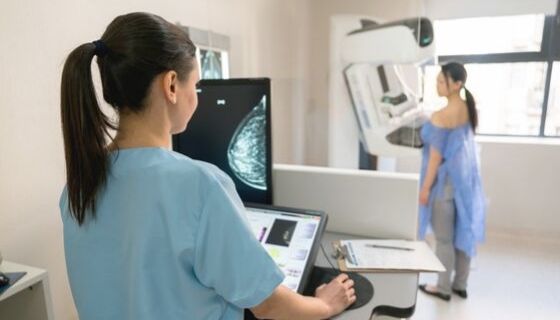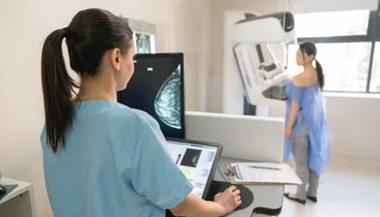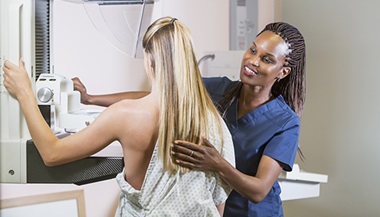Chest Ultrasound
What is a chest ultrasound?
A chest ultrasound is a noninvasive diagnostic exam that produces images, which used to assess the organs and structures within the chest, such as the lungs, mediastinum (area in the chest containing the heart, aorta, trachea, esophagus, thymus, and lymph nodes), and pleural space (space between the lungs and the interior wall of the chest). Ultrasound technology allows quick visualization of the chest organs and structures from outside the body. Ultrasound may also be used to assess blood flow to chest organs.
Ultrasound uses a transducer that sends out ultrasound waves at a frequency too high to be heard. The ultrasound transducer is placed on the skin, and the ultrasound waves move through the body to the organs and structures within. The sound waves bounce off the organs like an echo and return to the transducer. The transducer processes the reflected waves, which are then converted by a computer into an image of the organs or tissues being examined.
The sound waves travel at different speeds depending on the type of tissue encountered - fastest through bone tissue and slowest through air. The speed at which the sound waves are returned to the transducer, as well as how much of the sound wave returns, is translated by the transducer as different types of tissue.
An ultrasound gel is placed on the transducer and the skin to allow for smooth movement of the transducer over the skin and to eliminate air between the skin and the transducer for the best sound conduction.
Another type of ultrasound is Doppler ultrasound, sometimes called a duplex study, used to show the speed and direction of blood flow within the chest. Unlike a standard ultrasound, some sound waves during the Doppler exam are audible.
Ultrasound may be safely used during pregnancy or in the presence of allergies to contrast dye, because no radiation or contrast dyes are used.
Other related procedures that may be used to help diagnose problems in the chest include chest X-ray , chest fluoroscopy , computed tomography (CT scan) of the chest , lung biopsy , pleural biopsy , lung scan , mediastinoscopy , pulmonary angiogram and positron emission tomography (PET scan).
.png?h=200&iar=0&mh=360&mw=520&w=200&hash=34A9E666198EBF9014B2F04555242D21)
Anatomy of the respiratory system
The respiratory system is made up of the organs involved in the interchanges of gases, and consists of the:
-
Nose
-
Pharynx
-
Larynx
-
Trachea
-
Bronchi
-
Lungs
The upper respiratory tract includes the:
-
Nose
-
Nasal cavity/nasopharynx
-
Ethmoid
-
Frontal sinuses
-
Maxillary sinus
-
Sphenoid sinuses
-
Oral cavity/oropharynx
-
Larynx
-
Trachea
The lower respiratory tract includes the lungs, bronchi, and alveoli.
What are the functions of the lungs?
The lungs take in oxygen, which cells need to live and carry out their normal functions. The lungs also get rid of carbon dioxide, a waste product of the body's cells.
The lungs are a pair of cone-shaped organs made up of spongy, pinkish-gray tissue. They take up most of the space in the chest, or the thorax (the part of the body between the base of the neck and diaphragm).
The lungs are enveloped in a membrane called the pleura.
The lungs are separated from each other by the mediastinum, an area that contains the following:
-
The heart and its large vessels
-
Trachea (windpipe)
-
Esophagus
-
Thymus
-
Lymph nodes
The right lung has three sections, called lobes. The left lung has two lobes. When you breathe, the air enters the body through the nose or the mouth. It then travels down the throat through the larynx (voice box) and trachea (windpipe) and goes into the lungs through tubes called main-stem bronchi.
One main-stem bronchus leads to the right lung and one to the left lung. In the lungs, the main-stem bronchi divide into smaller bronchi and then into even smaller tubes called bronchioles. Bronchioles end in tiny air sacs called alveoli.
What are the reasons for a chest ultrasound?
A chest ultrasound may used to assess the presence of excess fluid in the pleural space or other areas of the chest, especially when the amount of fluid is small. If excess fluid is present, ultrasound may be useful to determine the type of fluid, exudate (seen in inflammatory, cancerous, or infectious conditions) or transudate (fluid that has leaked from blood or lymph vessels for various reasons). It can also be used to evaluate the heart and its valves. When used for this purpose, the procedure is called an echocardiogram .
Chest ultrasound may be performed to guide a needle during thoracentesis (puncture of the chest wall for the removal of fluids) or biopsy. Another use of chest ultrasound is to assess the movement of the diaphragm.
Chest ultrasound may be used along with other types of diagnostic methods, such as CT scanning , X-rays , or magnetic resonance imaging (MRI) for evaluation and diagnosis of conditions of the chest.
There may be other reasons for your physician to recommend a chest ultrasound.
What are the risks of a chest ultrasound?
There is no radiation used and generally no discomfort from the application of the ultrasound transducer to the skin.
There may be other risks depending on your specific medical condition. Be sure to discuss any concerns with your physician prior to the procedure.
Severe obesity may interfere with a chest ultrasound.
How do I prepare for a chest ultrasound?
-
Your physician will explain the procedure to you and offer you the opportunity to ask any questions that you might have about the procedure.
-
If an invasive procedure, such as a biopsy is to be done in conjunction with the chest ultrasound, you may be asked to sign a consent form that gives permission to do the procedure. Read the form carefully and ask questions if something is not clear.
-
Generally, no fasting or sedation is required before the procedure, but your physician may give your specific instructions if this is necessary.
-
If you are pregnant or suspect that you may be pregnant, you should notify your physician.
-
Dress in clothes that permit access to the area to be tested or that are easily removed. Although the gel applied to the skin during the procedure does not stain clothing, you may wish to wear older clothing, as the gel may not be completely removed from your skin afterwards.
-
Based upon your medical condition, your physician may request other specific preparation.
.png?h=172&iar=0&mh=360&mw=520&w=200&hash=8EF630551B8AA0C8A03DC446433F67B5)
What happens during a chest ultrasound?
A chest ultrasound may be performed on an outpatient basis or as part of your stay in a hospital. Procedures may vary depending on your condition and your physician's practices.
Generally, a chest ultrasound follows this process:
-
You will be asked to remove any clothing, jewelry, or other objects that may interfere with the scan.
-
If you are asked to remove clothing, you will be given a gown to wear.
-
You will be positioned on an examination table, either lying on your back or side, or sitting up with your arms raised and your hands clasped behind your neck, depending on the specific area of the chest to be examined.
-
Ultrasound gel is placed on the area of the body that will undergo the ultrasound examination.
-
Using a transducer, a device that sends out the ultrasound waves, the ultrasound wave will be sent through the area of your body being examined.
-
The sound will be reflected off structures inside the body, and the ultrasound machine will analyze the information from the sound waves.
-
The ultrasound machine will create an image of these structures on a monitor. These images will be stored digitally.
-
You may be asked to shift positions so that the technologist can obtain other views. You also may be asked to cough or sniff during the procedure, so that the movement of certain structures within the chest cavity can be observed.
While the chest ultrasound procedure itself causes no pain, having to remain still for the length of the procedure may cause slight discomfort, and the clear gel will feel cool and wet. The technologist will use all possible comfort measures and complete the procedure as quickly as possible to minimize any discomfort.
What happens after a chest ultrasound?
Generally, there is no special care following a chest ultrasound. However, your physician may give you additional or alternate instructions after the procedure, depending on your particular situation.





